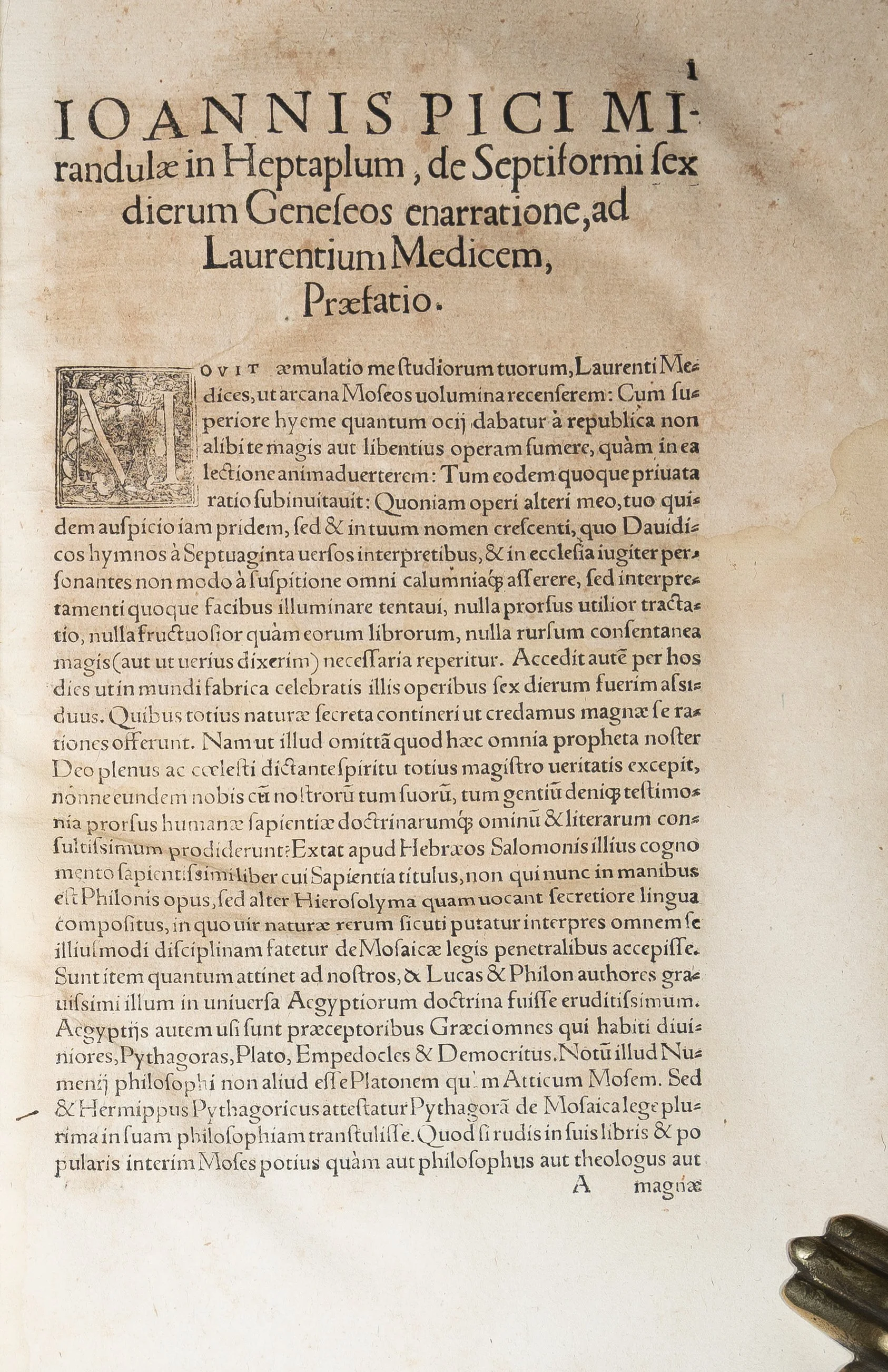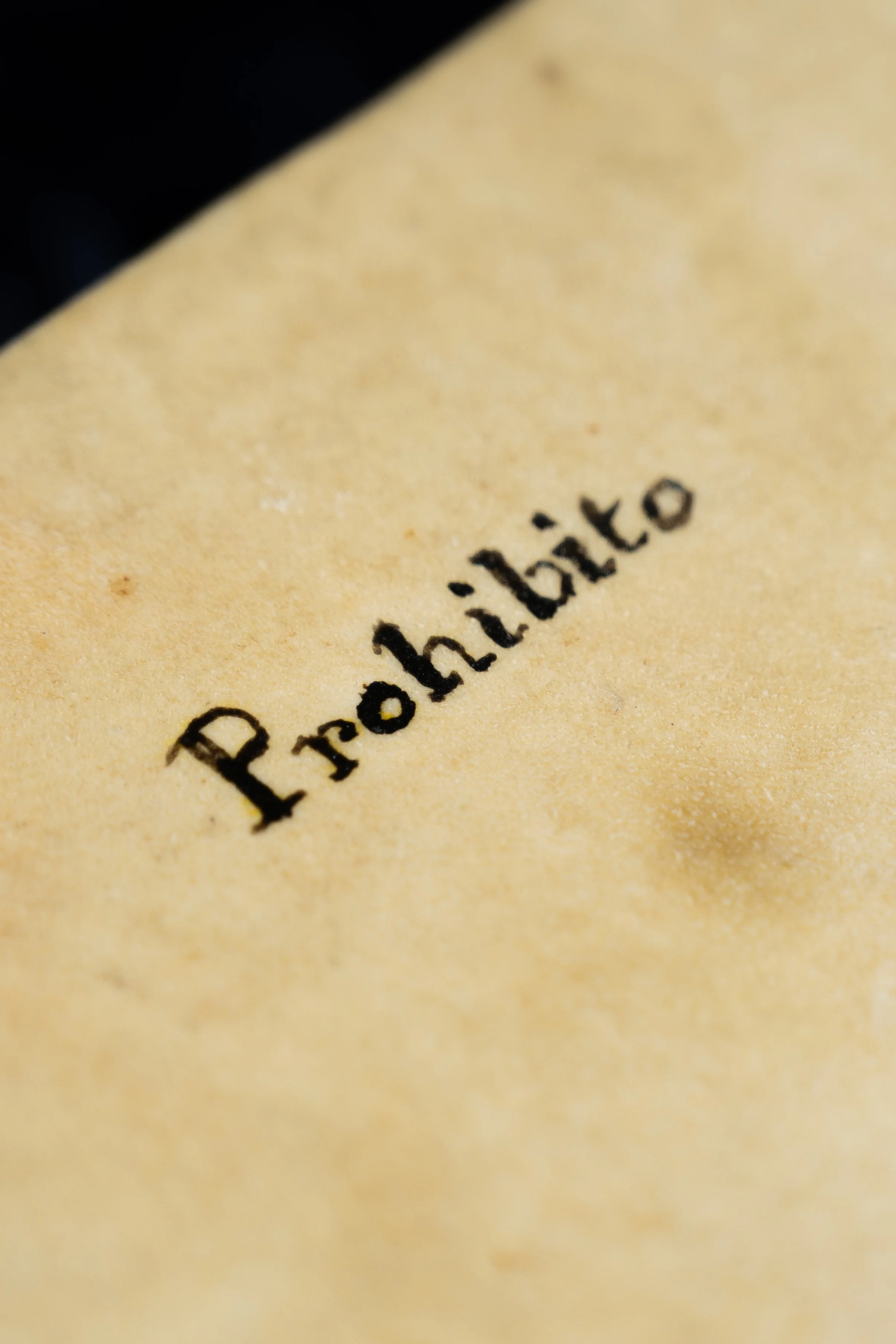 Image 1 of 7
Image 1 of 7

 Image 2 of 7
Image 2 of 7

 Image 3 of 7
Image 3 of 7

 Image 4 of 7
Image 4 of 7

 Image 5 of 7
Image 5 of 7

 Image 6 of 7
Image 6 of 7

 Image 7 of 7
Image 7 of 7








c. 1557-1601. "Prohibito": A Censored Pico della Mirandola on Astrology & Forbidden Kabbalah
This volume presents a substantial, albeit deliberately incomplete, collection of works by Giovanni Pico della Mirandola, the brilliant and audacious philosopher often seen as embodying the spirit of the Italian Renaissance. Its physical state tells a compelling story of intellectual controversy and censorship. Bound in contemporary parchment, the stark handwritten label "Prohibito" on the cover and the physical excision of nearly 165 pages dedicated to Kabbalah testify to the dangerous nature of Pico's syncretic explorations in the eyes of later authorities. Pico famously sought to harmonize diverse philosophical and mystical traditions – Platonic, Aristotelian, Hermetic, Arabic, and, crucially, Kabbalistic – believing they all contained echoes of a single, universal truth, a stance both celebrated and condemned.
Despite the censor's intervention, this volume retains Pico's profoundly influential and controversial Disputationes adversus astrologiam divinatricem. This treatise is famed for its sharp critique of predictive astrology, distinguishing it from acceptable natural astrology and arguing against its status as a true science – a bold move in an era where astrology held immense prestige. This stance may have had fatal consequences. An unpublished letter suggests Pico's challenge to the astrological establishment, potentially implicating powerful figures who relied on its predictions, could have been a motive for his mysterious death at the young age of 31, possibly involving orchestrated efforts to suppress his work.
The missing section (pages 733-897), removed by the Inquisition’s censor contains Reuchlin’s De Arte Cabalistica and has been removed in many editions. This highlights his pioneering role in introducing and legitimizing the study of Jewish mysticism within a Christian context. He believed the Kabbalah held profound secrets confirming Christian doctrines and unlocking ancient wisdom. Its removal here is a physical manifestation of the Counter-Reformation's suspicion towards such esoteric and interfaith explorations. This copy, with its restored binding, internal stains, and tell-tale excision, serves as a poignant artifact – a survivor bearing the physical scars of the battle over knowledge, faith, and forbidden ideas in the post-Renaissance world.
Ioannis Pici, Mirandulae Concordiaeque comitis... opera quae hoc autore felicissimè scripta sunt. [Collected Works]. Basileae [Basel]: [Ex Officina Henricpetrina - Printer inferred from device, likely Heinrich Petri or successors], [ca. 1557-1601 - Date not printed, common period for Petri editions]. Folio. [32], 732, 898-923 pp. Lacking pages 733-897, corresponding to the treatise De Arte Cabalistica, excised due to censorship. Bound in contemporary full parchment with restorations to hinges and spine. Handwritten inscription "Prohibito" on the front board; author and title handwritten on the rear board. Binding shows traces of old woodworm activity. Internally, water staining ("gore") is present on the title page and extending through parts of the volume. The final leaf has been backed, with the publisher's device on the colophon reportedly visible only when held against the light.
This volume presents a substantial, albeit deliberately incomplete, collection of works by Giovanni Pico della Mirandola, the brilliant and audacious philosopher often seen as embodying the spirit of the Italian Renaissance. Its physical state tells a compelling story of intellectual controversy and censorship. Bound in contemporary parchment, the stark handwritten label "Prohibito" on the cover and the physical excision of nearly 165 pages dedicated to Kabbalah testify to the dangerous nature of Pico's syncretic explorations in the eyes of later authorities. Pico famously sought to harmonize diverse philosophical and mystical traditions – Platonic, Aristotelian, Hermetic, Arabic, and, crucially, Kabbalistic – believing they all contained echoes of a single, universal truth, a stance both celebrated and condemned.
Despite the censor's intervention, this volume retains Pico's profoundly influential and controversial Disputationes adversus astrologiam divinatricem. This treatise is famed for its sharp critique of predictive astrology, distinguishing it from acceptable natural astrology and arguing against its status as a true science – a bold move in an era where astrology held immense prestige. This stance may have had fatal consequences. An unpublished letter suggests Pico's challenge to the astrological establishment, potentially implicating powerful figures who relied on its predictions, could have been a motive for his mysterious death at the young age of 31, possibly involving orchestrated efforts to suppress his work.
The missing section (pages 733-897), removed by the Inquisition’s censor contains Reuchlin’s De Arte Cabalistica and has been removed in many editions. This highlights his pioneering role in introducing and legitimizing the study of Jewish mysticism within a Christian context. He believed the Kabbalah held profound secrets confirming Christian doctrines and unlocking ancient wisdom. Its removal here is a physical manifestation of the Counter-Reformation's suspicion towards such esoteric and interfaith explorations. This copy, with its restored binding, internal stains, and tell-tale excision, serves as a poignant artifact – a survivor bearing the physical scars of the battle over knowledge, faith, and forbidden ideas in the post-Renaissance world.
Ioannis Pici, Mirandulae Concordiaeque comitis... opera quae hoc autore felicissimè scripta sunt. [Collected Works]. Basileae [Basel]: [Ex Officina Henricpetrina - Printer inferred from device, likely Heinrich Petri or successors], [ca. 1557-1601 - Date not printed, common period for Petri editions]. Folio. [32], 732, 898-923 pp. Lacking pages 733-897, corresponding to the treatise De Arte Cabalistica, excised due to censorship. Bound in contemporary full parchment with restorations to hinges and spine. Handwritten inscription "Prohibito" on the front board; author and title handwritten on the rear board. Binding shows traces of old woodworm activity. Internally, water staining ("gore") is present on the title page and extending through parts of the volume. The final leaf has been backed, with the publisher's device on the colophon reportedly visible only when held against the light.
